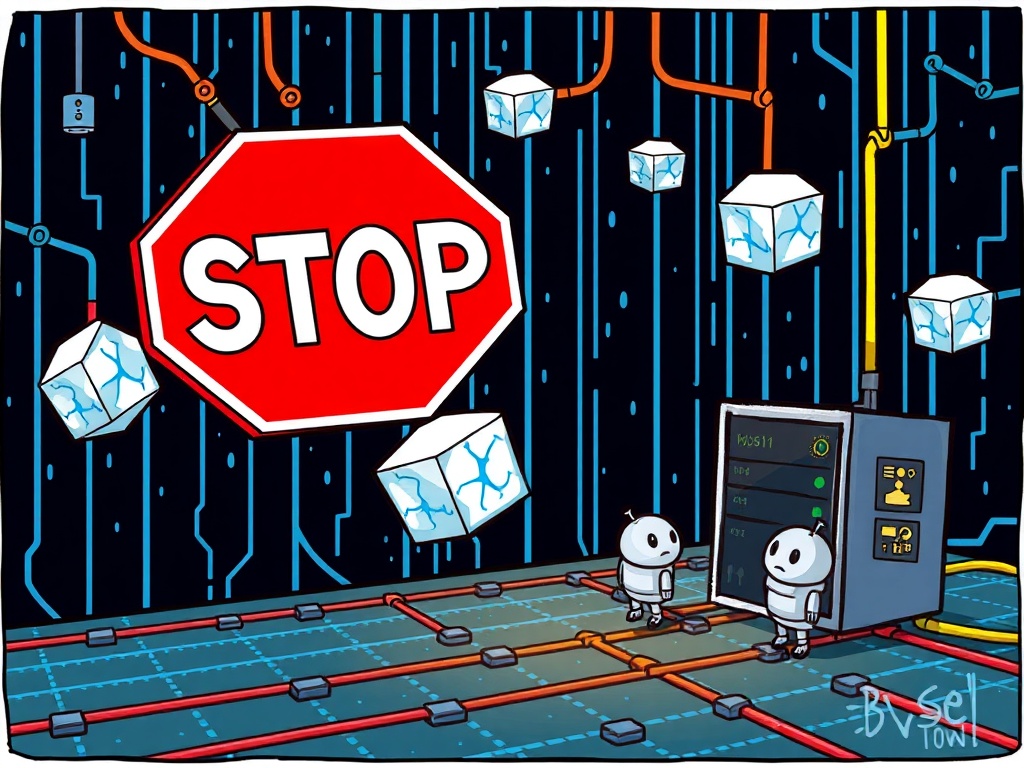BitcoinWorld

Base Network Halt: Unpacking the Critical Layer-2 Outage
The cryptocurrency world recently observed an alarming event: a Base network halt. Coinbase’s innovative Layer-2 network, Base, ceased producing new blocks for over 27 minutes. This unexpected interruption, confirmed by blockchain explorer BaseScan, immediately raised concerns across the crypto community regarding the network’s reliability and future network stability. Such incidents, while rare, highlight the critical importance of continuous blockchain block production for the seamless operation of decentralized applications and user transactions.
What Led to the Base Network Halt?
On a recent occasion, the Base network, a promising Layer-2 solution built on Ethereum, experienced a significant disruption. For a period exceeding 27 minutes, its regular blockchain block production came to an unexpected standstill. This meant that no new transactions were being processed or added to the blockchain, effectively pausing all activity on the network.
While the exact root cause of this specific Base network halt was not immediately detailed in public statements, such occurrences in blockchain networks can stem from various technical challenges. These might include:
- Software Bugs: Unforeseen errors in the network’s code.
- Consensus Issues: Problems among validators agreeing on the next block.
- Infrastructure Overloads: Excessive demand straining the network’s capacity.
- Security Incidents: Though less common for halts, these can disrupt operations.
Understanding the underlying reason for the halt is crucial for preventing similar issues and reinforcing network stability.
The Impact of the Layer-2 Outage
A prolonged Layer-2 outage, even for less than half an hour, can have noticeable repercussions for users and developers alike. When blockchain block production stops, the immediate effects are clear:
- Frozen Transactions: Users’ pending transactions cannot be confirmed.
- DApp Unavailability: Decentralized applications built on Base become unresponsive.
- Liquidity Concerns: Users may be unable to access or move their funds within the ecosystem.
This type of disruption can erode user trust, especially for a network backed by a major exchange like Coinbase. The incident underscores the delicate balance between scalability and reliability that Layer-2 solutions like Coinbase Base strive to achieve. Maintaining consistent uptime is paramount for mass adoption and fostering confidence in decentralized finance (DeFi).
How Did Coinbase Base Address the Incident?
In response to the Base network halt, attention quickly turned to how the development team behind Coinbase Base would manage the situation. Swift communication and transparent updates are vital during such events. While the initial news reported the halt, subsequent reports confirmed that the network resumed operations, indicating a resolution was implemented.
Typically, in such scenarios, development teams work tirelessly to:
- Identify the Cause: Pinpoint the precise technical issue.
- Deploy Fixes: Implement patches or reconfigure systems.
- Restore Services: Bring the network back online and resume blockchain block production.
- Communicate: Keep the community informed through official channels.
The speed at which Coinbase Base recovered from this incident is a testament to its operational resilience, a critical factor for any growing blockchain infrastructure.
Ensuring Future Network Stability and Blockchain Block Production
The recent Base network halt serves as a powerful reminder of the continuous effort required to ensure robust network stability in the blockchain space. For a rapidly expanding Layer-2 solution like Base, proactive measures are essential to prevent future disruptions to blockchain block production.
Key strategies for enhancing reliability include:
- Enhanced Monitoring: Implementing sophisticated systems to detect anomalies early.
- Redundancy Planning: Designing systems with backup components to prevent single points of failure.
- Rigorous Testing: Conducting extensive stress tests and audits before deploying updates.
- Decentralization Efforts: Further distributing network components to increase resilience.
By prioritizing these aspects, Coinbase Base can continue to build a foundation of trust and reliability, ensuring its position as a leading Layer-2 solution for the broader crypto ecosystem.
Conclusion: Navigating Challenges for a Stronger Base
The temporary Base network halt was a significant event, but its swift resolution highlights the commitment to maintaining operational integrity. Incidents like these, while inconvenient, often serve as crucial learning experiences that drive improvements in infrastructure and protocols. As the Coinbase Base ecosystem continues to evolve, its ability to quickly address and recover from challenges will be key to its long-term success and widespread adoption. The focus remains firmly on ensuring consistent blockchain block production and unwavering network stability for all users.
Frequently Asked Questions (FAQs)
What is Base Network?
Base is a Layer-2 blockchain network developed by Coinbase, designed to provide a secure, low-cost, developer-friendly way to build decentralized applications (dApps) on the Ethereum ecosystem.
Why did the Base Network halt block production?
The exact technical cause of this specific Base network halt was not publicly detailed, but such incidents can arise from software bugs, consensus issues among validators, infrastructure overloads, or other technical challenges.
How long did the Base network halt last?
According to blockchain explorer BaseScan, the Base network ceased producing new blocks for over 27 minutes during the incident.
Is it safe to use Coinbase Base after the incident?
The network quickly resumed operations, indicating that the issue was resolved. While no system is entirely immune to disruptions, Base’s rapid recovery demonstrates its team’s commitment to maintaining network stability and reliability.
What measures are being taken to prevent future halts?
To enhance future network stability, measures typically include enhanced monitoring, redundancy planning, rigorous testing of updates, and ongoing efforts towards greater decentralization of network components.
If you found this analysis of the Base network halt insightful, please share this article with your network. Help us spread awareness about the importance of network stability and blockchain reliability in the evolving crypto landscape.
To learn more about the latest Layer-2 network trends, explore our article on key developments shaping blockchain technology institutional adoption.
This post Base Network Halt: Unpacking the Critical Layer-2 Outage first appeared on BitcoinWorld and is written by Editorial Team





